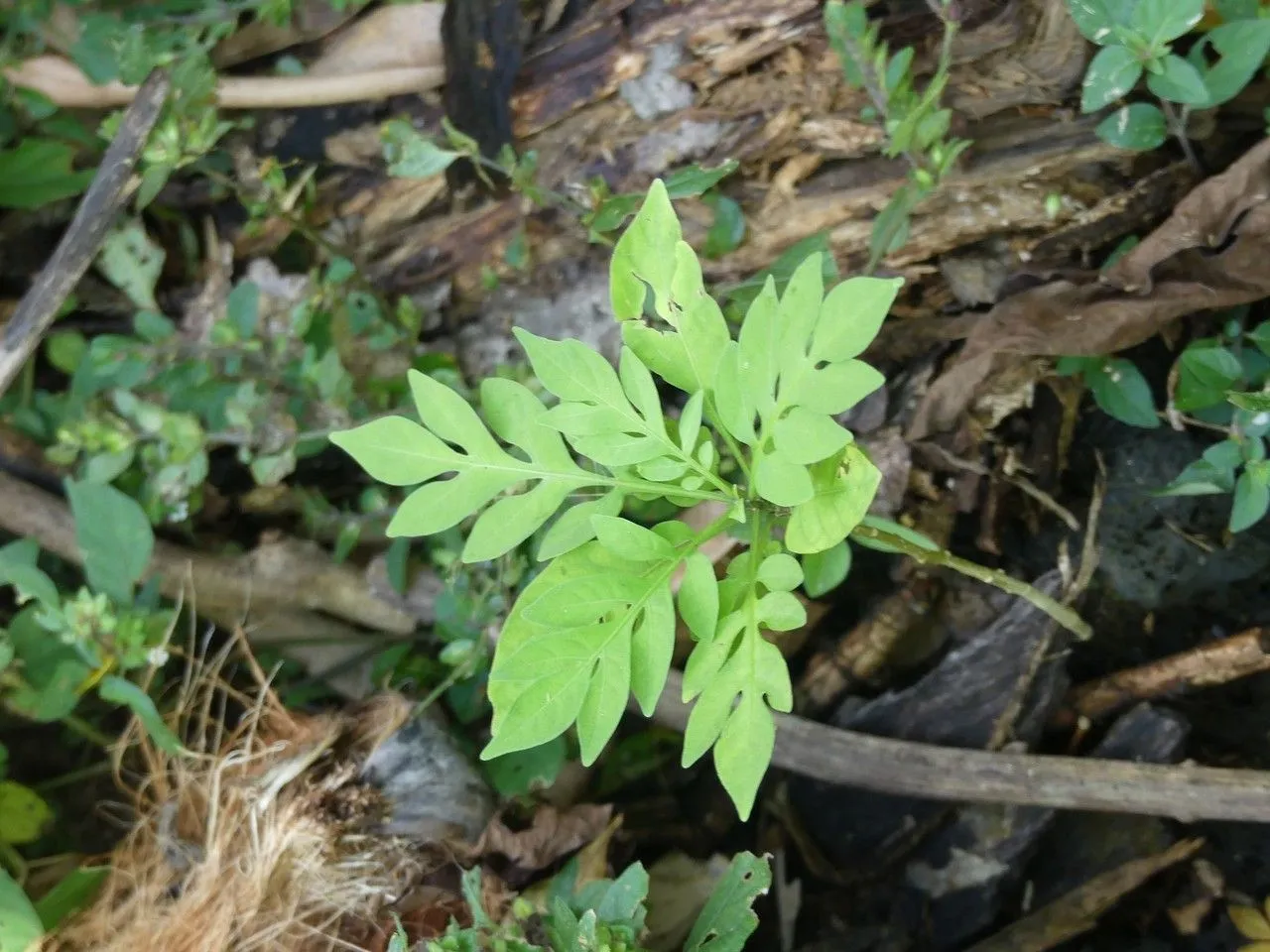
Author: Andrews
Bibliography: Bot. Repos. 8: t. 504 (1808)
Year: 1808
Status: accepted
Rank: species
Genus: Solanum
Vegetable: False
Observations: Florida to Caribbean, Mexico to Venezuela, Brazil (Fernando de Noronha)
The Brazilian nightshade, scientifically known as Solanum seaforthianum, is a fascinating plant that belongs to the Solanaceae family. This botanical species was first described by Andrews in the early 19th century, with its notable presence documented in the Botanical Repository in 1808.
Native to a wide range of tropical and subtropical regions, the Brazilian nightshade thrives from Florida and the Caribbean down to Mexico, extending further south through Venezuela and even reaching the Brazilian island of Fernando de Noronha. Its striking adaptability allows it to flourish in diverse climates and terrains, making it a common sight within its native range.
Characterized by its attractive green foliage and delicate, often violet-tinged flowers, Solanum seaforthianum is a visually stunning addition to any landscape. It is often noted for its climbing or sprawling growth habit, which enables it to cover structures and create lush, natural canopies. This feature is particularly appealing in ornamental gardening where it can be used to enhance the aesthetic appeal of arbors, trellises, and fences.
Beyond its beauty, the Brazilian nightshade is an important species in its native ecosystems. It serves as a habitat and food source for various pollinators and wildlife, contributing to the ecological balance and biodiversity of the areas it inhabits. However, this plant should be handled with care, as many members of the Solanaceae family possess toxic properties that can pose risks to humans and animals alike.
Cultivating Solanum seaforthianum requires a warm climate and well-draining soil. Ensuring adequate sunlight and moisture will promote vigorous growth and blooming. Gardeners and botanists alike appreciate the plant not only for its ornamental potential but also for its historical and botanical significance, as recorded in early botanical literature.
In summary, the Brazilian nightshade, Solanum seaforthianum, is a remarkable plant celebrated for its captivating appearance and ecological importance. Its widespread presence across the Americas and its cultivation requirements make it a notable species within the Solanaceae family, worthy of both appreciation and respect in botanical and horticultural circles.
Eng: brazilian nightshade, italian-jasmine, st. vincent-lilac, black nightshade, climbing nightshade, deadly nightshade, potato-creeper
Afr: aartappelranker
Deu: brasilianischer nachtschatten
Spa: guindilla
Por: trepadeira-doce-amarga
En: Brazilian nightshade, Climbing nightshade, Deadly nightshade, Potato-creeper, St. Vincent-lilac, Black nightshade, Italian-jasmine, Potato creeper, St Vincent lilac, Dwarf juniper
Af: Aartappelranker
Ar: حدق برازيلي
Zh: 南青杞, 星茄
De: Brasilianischer Nachtschatten
Ml: വള്ളിത്തക്കാളി
Pt: Trepadeira-doce-amarga
Es: Guindilla, Jazmín de Italia, Falsa belladona
Sv: Praktsöta
Zh-tw: 星茄
Uk: Паслін Зеафорта
Taken May 7, 2017 by Hugo SANTACREU (cc-by-sa)
Taken Jul 12, 2018 by Hugo SANTACREU (cc-by-sa)
Taken May 7, 2017 by Hugo SANTACREU (cc-by-sa)
Taken May 30, 2021 by Fernando da Luz Schmidt (cc-by-sa)
Taken May 30, 2021 by Fernando da Luz Schmidt (cc-by-sa)
Taken Jul 25, 2022 by Trap Hers (cc-by-sa)
Taken Jul 13, 2018 by Hugo SANTACREU (cc-by-sa)
Taken Jul 12, 2018 by Hugo SANTACREU (cc-by-sa)
Taken Jul 12, 2018 by Hugo SANTACREU (cc-by-sa)
Taken Jul 12, 2018 by Anziz AHMED ABDOU (cc-by-sa)
© copyright of the Board of Trustees of the Royal Botanic Gardens, Kew.
© copyright of the Board of Trustees of the Royal Botanic Gardens, Kew.
© copyright of the Board of Trustees of the Royal Botanic Gardens, Kew.
Taken May 7, 2017 by Hugo SANTACREU (cc-by-sa)
Taken May 7, 2017 by Hugo SANTACREU (cc-by-sa)
Taken May 7, 2017 by Hugo SANTACREU (cc-by-sa)
Taken May 7, 2017 by Hugo SANTACREU (cc-by-sa)
Taken May 7, 2017 by Hugo SANTACREU (cc-by-sa)
Taken Jan 1, 1900 by EOL − Bart Wursten (cc-by-nc)
Taken Jan 1, 1900 by EOL − W. L. Wagner (cc-by-nc-sa)
Taken Jan 1, 1900 by EOL − Petra Ballings (cc-by-nc)
Taken May 30, 2021 by Zoé Thivet (cc-by-sa)
Taken Jul 12, 2018 by Hugo SANTACREU (cc-by-sa)
Taken Oct 14, 2021 by sandra Borie (cc-by-sa)
Growth habit>: Vine
Family: Myrtaceae Author: (F.Muell.) K.D.Hill & L.A.S.Johnson Bibliography: Telopea 6: 402 (1995) Year: 1995 Status:…
Family: Rubiaceae Author: Pierre ex A.Froehner Bibliography: Notizbl. Bot. Gart. Berlin-Dahlem 1: 237 (1897) Year:…
Family: Sapindaceae Author: Koidz. Bibliography: J. Coll. Sci. Imp. Univ. Tokyo 32(1): 38 (1911) Year:…
Family: Asteraceae Author: A.Gray Bibliography: Pacif. Railr. Rep.: 107 (1857) Year: 1857 Status: accepted Rank:…
Family: Fabaceae Author: Medik. Bibliography: Vorles. Churpfälz. Phys.-Ökon. Ges. 2: 398 (1787) Year: 1787 Status:…
Family: Aspleniaceae Author: (Cav.) Alston Bibliography: Bull. Misc. Inform. Kew 1932: 309 (1932) Year: 1932…